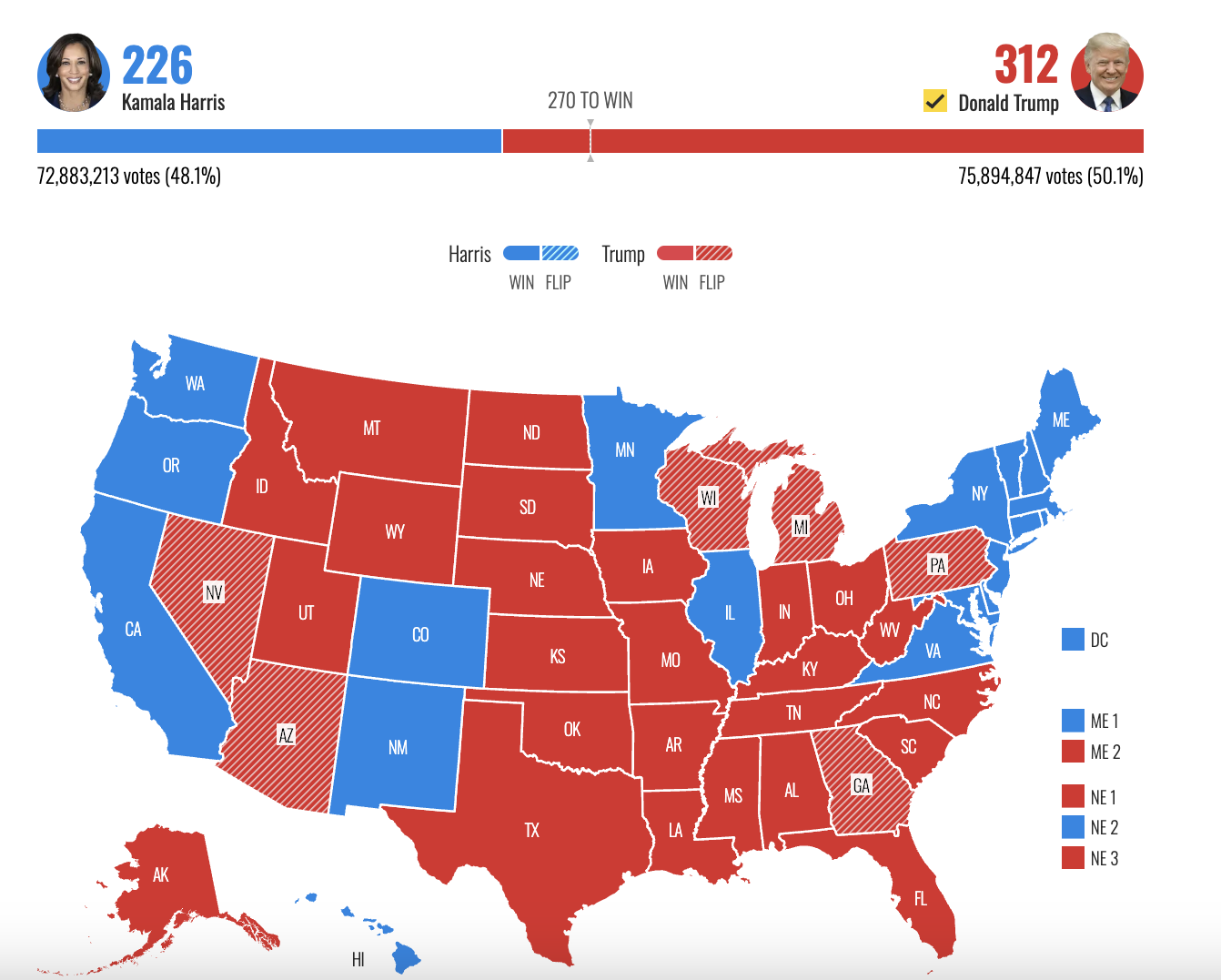Reflecting on Election Day
Presidential Election
With expectations of a tight race, both campaigns made concerted efforts to persuade and mobilize voters in the seven swing states of Pennsylvania, Michigan, Wisconsin, North Carolina, Georgia, Arizona, and Nevada. Polls indicated Vice President Harris leading in the traditional “Blue Wall” states, Pennsylvania, Michigan, and Wisconsin, and Nevada. While former President Trump was favored in Arizona, Georgia, and North Carolina. However, by the time polls closed on the West Coast at 11pm EST not only was former President Trump outperforming his 2020 results in all seven battleground states, but he was making strong showings in seemingly uncompetitive states like New Jersey, New York, and Virginia. Ultimately, former President Trump won all seven swing states claiming 312 Electoral Votes to Vice President Harris’ 226 becoming the second President to be elected to two non-consecutive terms, President Grover Cleveland being the other. Exit polls from the battleground states showed, despite pre-election polls indicating a tight race, President-elect Trump’s victory came from increased support amongst Latino men and voters who listed the economy as the issue most important to them. Voters who expressed anxiety about the economy broke for Trump by 80%, and voters who said inflation has caused a severe financial hardship for their family backed Trump by 74%. When NBC News asked what qualities mattered in deciding who to vote for 66% of respondents said President-elect Trump has the ability to lead and 74% said he can bring needed change. The below map displays the final Electoral College count. States with stripes are states that flipped from voting for Democrats in 2020 to voting Republican in 2024.

Senate Races
Facing an unfavorable map that forced them to defend several seats in battleground states and states President Trump won in 2020, Democrats and the Independents that caucus with them had an uphill climb to retain their slight 51-49 majority. With the retirement of Sen. Joe Manchin (I-WV), Republicans entered Election Day all but assured of flipping West Virginia. Sens. Jon Tester (D-MT) and Sherrod Brown (D-OH) were the most vulnerable Democrats with Sens. Bob Casey (D-PA), Tammy Baldwin (D-WI), and Jacky Rosen (D-NV) also drawing strong Republican challengers. In addition to those vulnerable incumbents, Democrats were also defending seats in swing states of Michigan and Arizona, with the retirement of Independent Senator Kyrsten Sinema. Ultimately, the unpopularity of the Biden-Harris Administration and strong electoral performance by President-elect Trump resulted in Republicans securing the majority by winning in West Virginia, Ohio, and Montana. While Republican challenger Dave McCormick was declared the winner of the Pennsylvania race the narrow margin of victory triggered an automatic recount under state law. This means Republicans currently have 52 Senate seats heading into the new Congress in January with the potential to add one more at the conclusion of the Pennsylvania recount. This will be the largest Senate majority since Republicans held 54 seats during the 114th Congress (2015-2016).

House Races
After a chaotic two-year stint in the majority that saw the removal of Kevin McCarthy (R-CA) as Speaker and forced his successor Mike Johnson (R-LA) to rely on Democratic to pass several pieces of legislation, most polls showed a tight race for control of the U.S. House of Representatives but with a slight advantage to Democrats. Nearly eight days after the last polls closed on Election Day, Republicans officially reached 218 seats and retained the majority of the House. While there are still a handful of races left to be called, Republicans may only have a 4-seat majority. This would mirror the majority Republicans held for most of the past two years, which could make Speaker Johnson once again reliant on Democratic votes to pass major legislation that hard-right Republican members oppose. This majority could be even tighter given the likely resignations of Elise Stefanik (R-NY) and Mike Waltz (R-FL) to serve in the Trump Administration. In a sudden development, Florida Rep. Matt Gaetz announced his immediate resignation from Congress on November 13, the same day President-elect Trump nominated him to be Attorney General. Numerous news outlets reported Gaetz’s resignation was done to prevent the release of a potentially damaging report by the House Ethics Committee into Gaetz’s conduct. Stefanik, Waltz, and Gaetz all represent very conservative districts, so there is no danger of Democrats flipping those seats, but because all three seats will need to be filled via special election, it could take months for successors to be sworn in, which will reduce the Republican majority until those elections take place.

